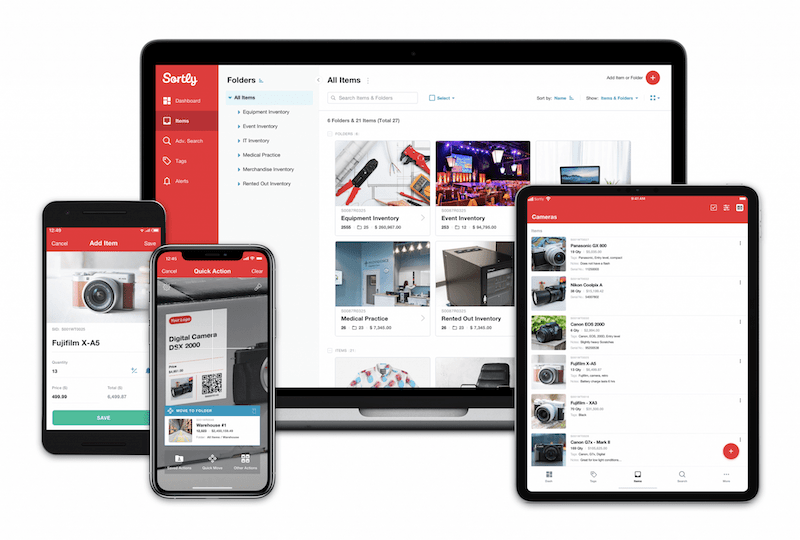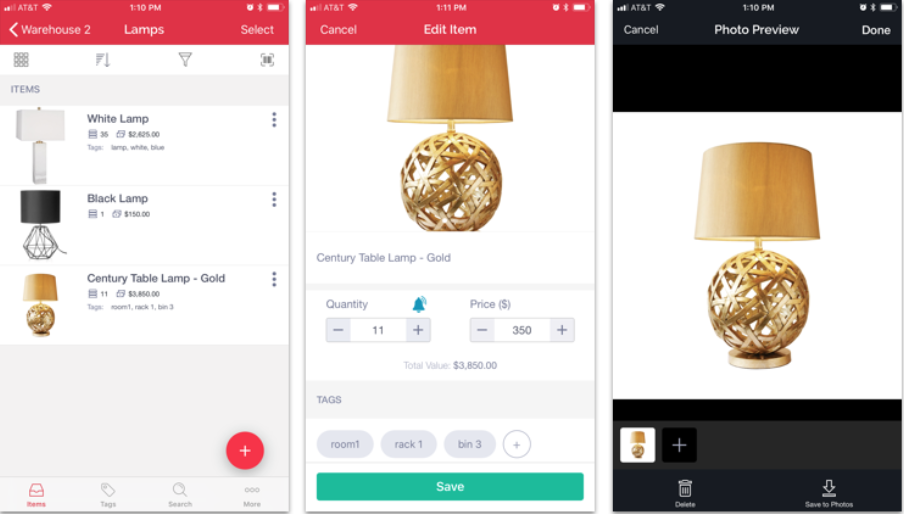Whether you sell translations or t-shirts, your business almost certainly tracks assets, too. Assets are any investment your company has made. Think standing desks, smartphones, and that fancy-pants espresso maker. While you may use these assets directly or indirectly, two things are for sure: your business needs them, and they’re worth something.
That’s why assets need to be tracked, much like traditional inventory that’s bought and sold. So whether you need to track depreciating assets, need to manage equipment across multiple locations, or just want to know where all your stuff is, the right asset tracking software can help your business stress less, do more, and stay organized for good.
In this article, we’ll reveal ten features you absolutely need in an asset tracking software.
1. Simple, flexible inventory dashboard

First things first. When you’re hunting for the right app to help you keep track of your assets, you need one that offers a robust but manageable dashboard where you can see all your stuff–all in one place. No matter what you track, you want to know what you’ve got, where it is, and how much you’ve got.
Another must-have: photos. Many assets have similar names or are stored in hard-to-reach boxes. By uploading high-resolution photos to your inventory app, you can suddenly make sense of everything you’ve got—all by taking a quick glance at your phone, tablet, or computer.
Related: A Guide to Visual Inventory Control
2. Customizable item details
Next up, asset and inventory item details that you can customize to a T. Because no two businesses are alike, and most companies crave tons of flexibility regarding item details. After all, what’s important to you is what you need to track.
So look for inventory management software that lets you pick and choose what you track and record. First, of course, you’ll need the basics: size, location, condition, and vendor. But don’t forget about pictures, attachments, barcodes and QR codes, random notes, and “custom fields” to track all the tiny details that are important to you.
Anything you’d scribble on a sheet of paper or slap on a sticky note, you should be able to track easily in item details, too.
3. Flexible categories, folders, and tags
Next up, you’ll want complete control of how you set up your asset management software’s hierarchy. Since all companies are slightly different, you definitely don’t want an inventory app engineer to decide the best way to organize all your stuff. (That’s your job!)
With an app like Sortly, you have the final say in just how you organize your inventory. For example, you can simply create two folders: “Available Inventory” and “Out.” Or you can make a folder for every office or storage facility you have. Or you can simply use categories to denote where something is.
The choice is yours entirely. Find out what works for your business and your brain, then implement it. Or, chat with Sortly’s friendly support team to create a system that works for you.
4. Ability to track assets across multiple locations
Since we’re talking about folders, we might also talk about tracking inventory across multiple locations. This is one of the most significant pain points for business owners and other employees we talk to. They can handle asset tracking at one place, or another. But getting that big picture, and seeing how all this inventory connects across the state, country, or world, can be tricky.
Luckily, modern and intuitive inventory apps like Sortly making tracking inventory that’s all over the country a breeze. For example, you can see what laptops in Los Angeles and what desktop is in Denver with one glance. Plus, you can decide precisely how you show different locations: through folders, categories, or even tags.
5. Easy, intuitive tracking of value and costs

Next on the list: a simple way to track how much things are worth. This is especially important for businesses with many high-value items or who need to follow depreciating assets carefully. When you use asset tracking software like Sortly, it’s easy to plug in an item’s purchase price, condition, and current value.
And that means when your accountant or corporate or anybody else needs an update, getting them that information takes seconds, not six weeks. If your business has tons of depreciating assets, like expensive office furniture, these reports can be super helpful for tax purposes, too.
6. Barcode and QR code syncing
If you’re looking to save time, money, and stress with an inventory app, barcode and QR code scanning is an absolute must. These powerful automation features allow you to scan any item in your inventory, so you can make updates, learn more about the item, edit its details, or share information with a colleague.
Barcodes and QR codes also help users save tons of time when conducting inventory counts and audits. And they come in handy whenever a box is just out of reach or items look alike.
With Sortly, customers can use the in-app scanner on their smartphones and tablets to read barcodes and QR codes or sync external Bluetooth scanners with the inventory software. Whatever your team prefers, Sortly can help make barcode and QR code scanning that much easier.
7. Customizable barcodes and QR codes for unlabeled assets

Another major benefit of modern inventory software: you can create barcodes and QR codes for any unlabeled stock. That means that if your business creates bundles of equipment (maybe a laptop, mouse, and extra monitor), you can package them and label them as one unit. Talk about a time saver.
Same goes for proprietary stuff and other items that don’t come with barcodes. Think fine art, coffee machines, even standing desks. You can create custom labels for all those things, sync them to item details, and automate your inventory in a flash.
8. Alerts for low stock, expiring items, warranty, and rental period ends
Ever run out of printer ink? Realized that super fancy copy machine of yours had fallen out of warranty before you got it fixed? Needed to rent out a bunch of tables and chairs but weren’t quite sure when they’d be back from another event?
The right asset tracking software can help you get a handle on all of this. And it all starts with customizable alerts. You decide if, when, and how you want to be contacted should an item’s stock run low, approach expiration, warranty end, or rental period end. Alerts can happen in-app, via email, or both. And you decide who gets notified and how frequently.
9. Instant, insightful reports
Next up: reports. Customized, easy-to-generate reports are an integral part of any inventory app. And they’re a significant benefit to tracking all your business’s stuff digitally. Last-minute meeting? Chat with a client? You can instantly pull together a beautiful, informative PDF or CSV of all the inventory you need to know about now.
These reports can be used internally to help forecast and practice inventory control, show clients what kinds of assets are available for them, to help speed up inventory audits. And, as we mentioned, they are also super helpful for corporate compliance and accounting purposes.
10. Perfect for teams and businesses with multiple offices
Finally, when you choose asset tracking software, make sure to pick one that’s built for teams. If you’ve got tons of people in your office, an app like Sortly will allow you to offer custom user permissions and just-right access to employees. If you’re just one or two people, using an app that helps you to grow and scale can save you time, money, and stress in the future.
Best of all, when users use an app like Sortly from their own account, you’ll automatically have a record of everything that happens to your inventory. These item histories can really come in handy, especially if you have questions or concerns.
Ready to streamline your asset tracking with easy-to-use asset tracking software? Try Sortly free today.




